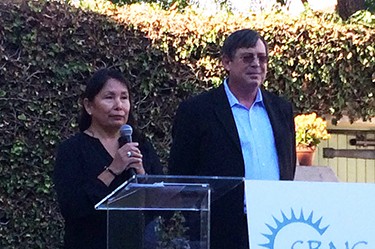With funds and new CEO, Neighborhood Clinics turn the corner
IN THIS ARTICLE
- Health Care & Life Science Topic
- Marlize van Romburgh Author
By Marlize van Romburgh Thursday, November 21st, 2013

Trula Breuninger, CEO of Santa Barbara Neighborhood Clinics, left, and Mark Palmer, president of the board at a Nov. 21 press conference to discuss the nonprofit’s progress since declaring a financial emergency in May. (Business Times photo)
The struggling Santa Barbara Neighborhood Clinics nonprofit is narrowing its funding gap and has a strategic plan and new permanent CEO in place, putting it on track to become financially sustainable at a time when it looks to expand service to Goleta.
“Six months ago, we were in danger of closing our doors,” said Mark Palmer, president of the board of the nonprofit, speaking at a Nov. 21 press conference. “I can tell you now that we have weathered that storm.”
SBNC operates three affordable health care clinics and a dental clinic on the South Coast. The nonprofit clinic network provides free or low-cost health care to uninsured and underserved members of the community, and it’s the only organization in the county to do so, excluding clinics that serve exclusively veterans or homeless individuals.
Since kicking off a 100-day plan to regain its financial footing, the organization received $600,000 in donations from a group led by the Santa Barbara Foundation. The funds were tied to monthly goals and the implementation of a strategic plan. SBNC said that through a new operation plan, it will gain upwards of $1 million in cost savings per year.
At the same time, the organization recently received a large grant from The Health Resources and Services Administration, a federal agency, to open a new clinic in Goleta’s Old Town neighborhood. The funds are part of a Medicaid expansion under the Affordable Care Act and include an immediate grant of $812,500 plus annual funding of $650,000 starting in 2014. The nonprofit is currently looking for a facility of about 11,000 square feet to house the new clinic.
Palmer said SBNC has been able to make “a really positive transition” as a result of generous community support, combined with a new operating plan.
Trula Breuninger, who was brought in as interim CEO this summer, now holds that position on a permanent basis. She has previously served as CEO for community health care organizations including the San Diego American Indian Health Center and, most recently, the Southern Indian Health Council in Alpine, Calif. Breuninger received her MBA from the W.P. Carey School of Business at Arizona State University and a master’s degree in public health from UC Berkeley.
SBNC, which in May said it was in danger of closing its doors due to a funding crisis, said Nov. 21 that its new operational plan has allowed it to bring its monthly deficit down to $100,000 a month from $250,000. Long-term, the group expects its funding gap to be about $75,000 a month or $800,000 a year, Palmer said. The deficit — the difference between the group’s operating revenues and its expenses — is the amount SBNC seeks in community support.
Breuninger said the group was able to cut costs in part by outsourcing some positions. SBNC had 103 staff positions when she started, she said; it now has 94.
SBNC said its turnaround comes at the same time that it is experiencing record demand for low-cost primary care. Last month, the group’s clinics experienced record patient visits, with 5,187 people turning to the nonprofit for free or low-cost health care. SBNC’s dental clinic saw about 1,500 people, up from its usual monthly figure of 1,000 to 1,200 patients, executives said.
“Our motto is: ‘If you think you need to be seen, you do, and we’re going to get you in,” said Dr. Charles Fenzi, the group’s chief medical officer. Despite the nonprofit’s financial woes, patients have experienced no disruption in service, he said.
The clinics have averaged about 17,000 patient visits a year. About one-third of those patients are non-reimbursable, with SBNC receiving little or no revenue from either patients or the government.
Breuninger said the group believes that higher government reimbursement rates will kick in as a result of the clinics implementing electronic medical records. The organization also believes that with health care reform, many patients who had previously been ineligible for government funds will now become eligible, also resulting in more revenue for the clinics.
SBNC’s leaders cautioned that the group still needs community support and that the fate of its Isla Vista clinic remains unclear. The Isla Vista clinic serves a different demographic than the proposed new clinic in Goleta’s Old Town, Palmer said. The county-owned property on which the Isla Vista clinic sits is at risk of being sold as part of the dissolution of redevelopment agencies in California. Earlier this year, county leaders were asked by the state to prove that the property was being used for government uses. Palmer said that while the issue has not been definitively resolved, he believes that SBNC has enough political support on its side to retain the facility. The Santa Barbara County Board of Supervisors voted to keep the clinic, and the matter is currently under consideration in Sacramento.










